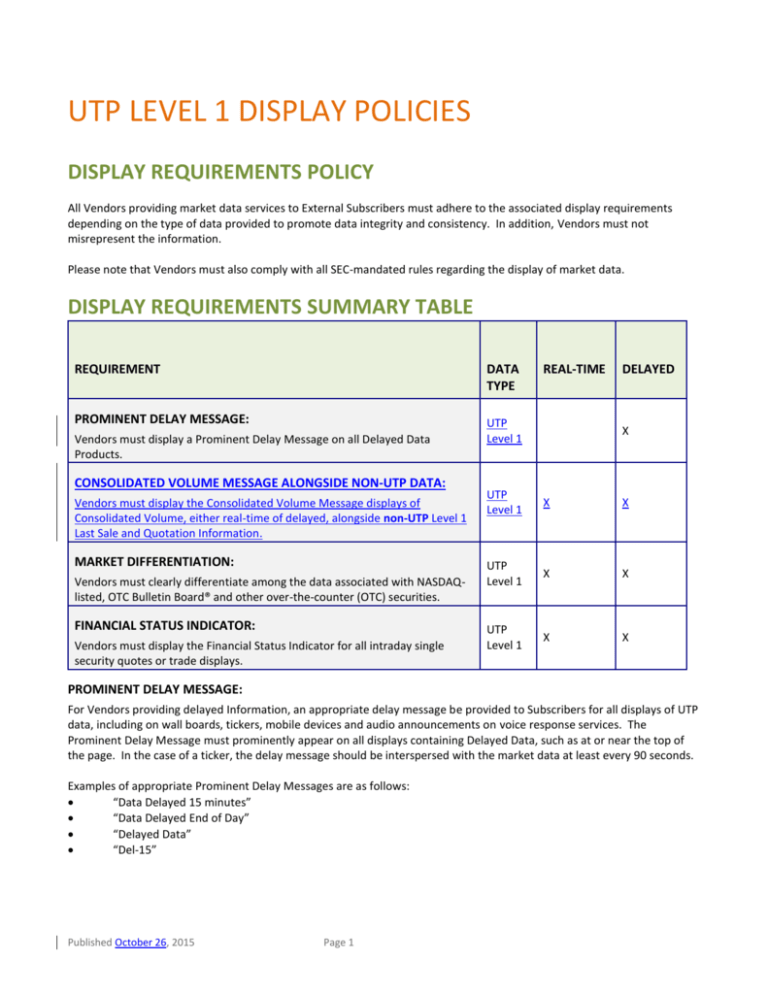UTP Display Policies
advertisement

UTP LEVEL 1 DISPLAY POLICIES DISPLAY REQUIREMENTS POLICY All Vendors providing market data services to External Subscribers must adhere to the associated display requirements depending on the type of data provided to promote data integrity and consistency. In addition, Vendors must not misrepresent the information. Please note that Vendors must also comply with all SEC-mandated rules regarding the display of market data. DISPLAY REQUIREMENTS SUMMARY TABLE REQUIREMENT DATA TYPE PROMINENT DELAY MESSAGE: UTP Level 1 Vendors must display a Prominent Delay Message on all Delayed Data Products. CONSOLIDATED VOLUME MESSAGE ALONGSIDE NON-UTP DATA: Vendors must display the Consolidated Volume Message displays of Consolidated Volume, either real-time of delayed, alongside non-UTP Level 1 Last Sale and Quotation Information. MARKET DIFFERENTIATION: Vendors must clearly differentiate among the data associated with NASDAQlisted, OTC Bulletin Board® and other over-the-counter (OTC) securities. FINANCIAL STATUS INDICATOR: Vendors must display the Financial Status Indicator for all intraday single security quotes or trade displays. REAL-TIME DELAYED X UTP Level 1 X X UTP Level 1 X X UTP Level 1 X X PROMINENT DELAY MESSAGE: For Vendors providing delayed Information, an appropriate delay message be provided to Subscribers for all displays of UTP data, including on wall boards, tickers, mobile devices and audio announcements on voice response services. The Prominent Delay Message must prominently appear on all displays containing Delayed Data, such as at or near the top of the page. In the case of a ticker, the delay message should be interspersed with the market data at least every 90 seconds. Examples of appropriate Prominent Delay Messages are as follows: “Data Delayed 15 minutes” “Data Delayed End of Day” “Delayed Data” “Del-15” Published October 26, 2015 Page 1 CONSOLIDATED VOLUME MESSAGE ALONGSIDE NON-UTP DATA: Vendors displaying Consolidated Volume, either real-time of delayed, alongside non-UTP Level 1 Last Sale and Quotation Information must display a Consolidated Volume Message on all displays of UTP Information, including on wall boards, tickers, mobile devices and audio announcements on voice response services. The Consolidated Volume Message must prominently appear on all relevant displays, such as at or near the top of the page. In the case of a ticker, the delay message should be interspersed with the market data at least every 90 seconds. Vendors redistributing Consolidated Volume, either real-time or delayed, on a Data Feed are required to ensure that downstream Data Feed Recipients that display the Consolidated Volume alongside non-UTP Level 1 Last Sale and Quotation Information on the same screen are also displaying a Consolidated Volume Message on all displays of UTP Information. Examples of appropriate Consolidated Volume Messages are as follows: “Real-Time quote and/or trade prices are not sourced from all markets.” or “Delayed quote and/or trade prices are not sourced from all markets.” If any advertising or marketing material contains Consolidated Volume alongside non-UTP Level 1 Last Sale and Quotation Information, then the Consolidated Volume Message is required. MARKET DIFFERENTIATION: Vendors providing UTP Level 1 Information to External Subscribers must clearly differentiate among the data associated with NASDAQ-listed, OTC Bulletin Board and other over-the-counter (OTC) securities. To differentiate the data, Vendors may use the Listing Market or Market Category, defined as the market on which the security is listed. LISTING MARKET IDENTIFIER SUGGESTED ABBREVIATION NAME NASDAQ U.S. “NASDAQ” or “Q” OTC Bulletin Board “OTCBB” or “U” Other OTC Equity “OTC” or “u” As a service to Vendors and investors, multiple sources are available for Listing Market or Market Category information. Vendors may access the Tape C Symbol Directory and OTCBB Symbol Directory to download a file with the current issue symbols for each market. In addition, symbol changes and market center changes are available on the Daily List. Vendors receiving market data indirectly via a retransmission Data Feed product should consult their Redistributor/data provider for further information regarding how the Listing Market is conveyed on the Data Feed. FINANCIAL STATUS INDICATOR: Vendors providing Information to External Subscribers that are subject to the SEC Vendor Display Rule are required to provide the Financial Status Indicator (FSI) to downstream Subscribers accessing intraday single security quotation displays or Data Feed products. The FSI is a data element that denotes when a NASDAQ-listed issuer had failed to submit its regulatory filings on a timely basis, failed to meet The NASDAQ Stock Market’s continuing listing standards and/or filed for bankruptcy. The FSI was added to the data products at the request of the SEC. The FSI field should be shown with the issue symbol and company name near the top of the quotation display. When the FSI value is published as “N” (Normal), Vendors are not required to display any information. Vendors are not required to provide the FSI on voice port devices or television services. If a voice port or television service offers news information, however, the Vendor may want to create a news alert based on the FSI value when the FSI for an issue is not "N" (Normal). Please refer to DATA NEWS ITEM #2005-57 to obtain the FSI code values and descriptions. Page 2 DISPLAY RECOMMENDATIONS POLICY DISPLAY RECOMMENDATIONS To increase investor understanding, the following display recommendations are provided: UTP LEVEL 1 REAL-TIME DELAYED X X MARKET TIER DIFFERENTIATION: NASDAQ U.S. NASDAQ It is recommended that all real-time and delayed data Vendors differentiate between the market tiers for UTP. SEC REGULATION SHO – RULE 201 INDICATOR: NASDAQ U.S. Effective February 28, 2011, it is recommended that all real-time Vendors display a Short Sale Price Test Restricted Indicator to denote when a short sale circuit breaker has been triggered under Rule 201 of SEC Regulation SHO. The SEC Regulation SHO Price Test Indicator is disseminated as a standalone message on the UTP direct Data Feed products. X SEC REGULATION SHO - RULE 203 SECURITY INDICATOR: NASDAQ U.S. Effective January 3, 2005, it is recommended that all real-time Vendors display the SEC Threshold Security Indicator to denote when a security is subject to the locate and delivery requirements of Rule 203 of SEC Regulation SHO. The SEC Threshold Indicator is included in the Stock Directory on the UTP Data Feed products. X MARKET TIER DIFFERENTIATION: NASDAQ U.S. It is recommended that all real-time and delayed data Vendors differentiate between the market tiers within the NASDAQ U.S. market. The Market Tier is defined as the market on which the security is listed. The Market Tier field denotes the market tier classification for the NASDAQ Equity-listed issue in the directory message. MARKET TIERS NASDAQ Global Select Market SM NASDAQ Global Market ® NASDAQ Capital Market SUGGESTED LISTING MARKET IDENTIFIER SM “NASDAQ GS” or “Q” “NASDAQ GM” or “G” “NASDAQ CM” or “S” As a service to Vendors and investors, multiple sources for NASDAQ U.S. Market Tier information are provided. The market tier (formerly known as market category) is identified for its listed companies within the Issue Symbol Directory (Category A — Type B) message format on the UTP Data Feed products. Please note that Vendors receiving market data via a retransmission Data Feed provider should consult their provider for further information regarding how the Market Tier is conveyed on the Data Feed. The Market Tier field is also included in the Issue Symbol Directory, Daily List and Fundamental ® Data files on the NASDAQ Trader website. Vendors may also access the Symbol Directory to download a file with the current issue symbols for each Market Tier. Page 3








